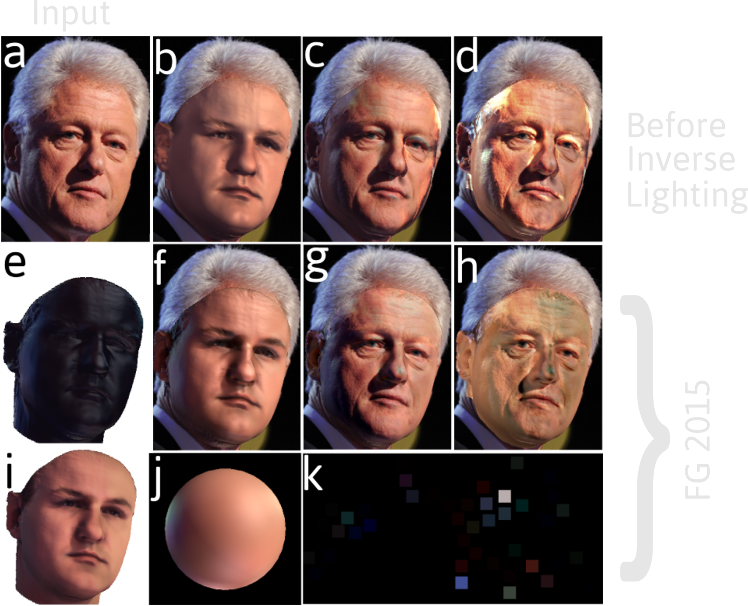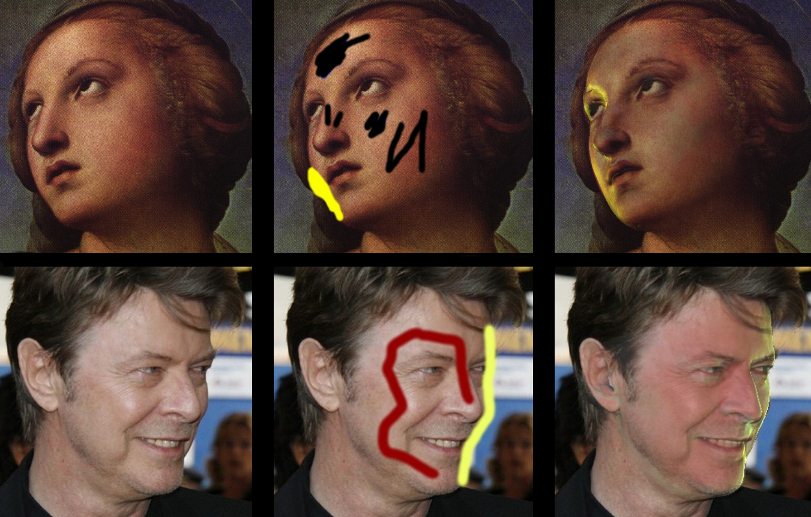| |
|
|
|
|
|
|
|
Inverse Lighting |
|
|
|
| |
|
|
| |
Inverse Lighting is the estimation of the lighting of a scene from its appearance. |
|
| |
|
|
| |
Lighting can severely change the appearance of the human face and confound the information which is needed for reconstruction of the face model and face recognition. Not only emitters but also surrounding objects, also from the off-screen space, influence the illumination; objects such as walls, ground, cloths, etc. Inverse rendering methods usually deal with the estimation of illumination from the given image data. In this project, the main focus is the estimation of a lighitng model -a Virtual Light Stage (VLS)- for the given image. |
|
| |
|
|
| |
Once the lighting model is estimated, it is possible to calculate the illumination effects on the object. A more precise intrinsic appearance decomposition in geometry, texture (albedo) and illumination can be achieved. This project aims for harsh illumination conditions and addresses realistic illumination effects for non-lambertian surfaces of non-convex geometry of faces. Cast shadows, specular highlights and Fresnel effects at grazing angles, colorful illumination and multiple lighting directions are the goals that this project achieves. The illumination is estimated from a generating set, synthesized by a 3DMM (3D Morphable Model) framework. The fitting algorithm of the 3DMM is used to estimate the face model from the input image, in an earlier step. Beside illumination estimation and intrinsic appearance deconstruction, other outcomes and playgrounds for the project include: Relighting and Lighting Design, Lighting Transfer, Scene Reconstruction, Environment Modeling, etc. . |
|
| |
|
|
| |
 |
| (a) is the original image, (b) the estimated model and lighting by 3DMM, (c) the reconstruction with 3DMM's result and pixel values from (a), (d) de-illuminated (intrinsic) face model with 3DMM's estimation. The proposed results: (e) is the specular lightmap, (f) the lighting with to be compared with (b), (g) the reconstruction to be compared with (c), (h) the intrinsic texture to be comapred with (d), (i) the diffuse lightmap, (j) an sphere, with average skin albedo, rendered under the estimated lighting, and (k) the estimated light sources (the VLS). |
|
|
| |
|
|
| |
One of the applications of our project is the creative lighting design software, which works on single face images. The software allows users to provide the intended design for the lighting with a simple sketch. The rest is done automatically by software. The face model is estimated, the albedo of the face model is corrected to the highest possible quality. Separately, the lighting is estimated as an optimal compensation for the painted-on image. Finally, the intrinsic face model is rendered under the estimated lighting. |
|
| |
|
|
| |
 |
| See ICIP 2016 |
|
|
| |
|
|
| |
Links: |
|
| |
|
|
| |
|
|
|
|
|
|
 |
|
|
| |
|
|
|
|
|
|
| |
|
|
|
|
|
|

